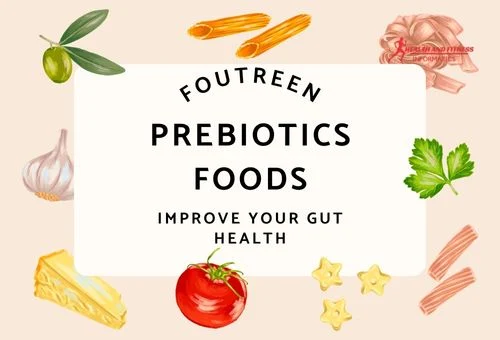14 Prebiotics Foods: How they Help to Improve Your Gut Health
Overview:
Prebiotic foods are rich sources of dietary fiber that provide nourishment to beneficial bacteria in our gut. These foods contain specific types of carbohydrates, such as inulin, fructooligosaccharides (FOS), and resistant starch, which are not digested by our bodies but instead reach the colon intact. Once in the colon, these prebiotic fibers are fermented by gut bacteria, promoting their growth and activity.
Difference between Prebiotics and Probiotics:
Prebiotics are non-digestible fibers that nourish beneficial gut bacteria, while probiotics are live bacteria that directly introduce beneficial microorganisms into the gut. Both prebiotics and probiotics play important roles in supporting a healthy gut microbiome and overall well-being.
Here are some detailed differences between prebiotics and probiotics, so stay connected with us we have much more to explore your healthier life after that.
1. Definitions:
Prebiotics:
Prebiotics are fibers and non-digestible that serve as a food supply for helpful bacteria present in the gut.
Probiotics:
They are live yeast and bacteria that, when consumed, provide health benefits by improving the balance of gut bacteria.
2. Examples:
Prebiotics:
Foods rich in prebiotics include bananas, onions, garlic, asparagus, oats, and legumes.
Probiotics:
Examples of probiotics include yogurt, kefir, sauerkraut, kimchi, and certain dietary supplements.
3. Source:
Prebiotics:
Prebiotics are primarily obtained through the consumption of fiber-rich foods like vegetables, fruits, legumes, and whole grains.
Probiotics:
Probiotics can be present in certain foods like fermented vegetables and fermented dairy products, as well as in probiotic supplements.
4. Function:
Prebiotics:
Prebiotics support the growth and activity of beneficial bacteria in the gut, aiding in maintaining a healthy gut microbiome.
Probiotics:
Probiotics directly introduce live bacteria into the gut, which can help restore or enhance the balance of gut bacteria.
5. Mode of Action:
Prebiotics:
Prebiotics are non-living substances that pass through the digestive system undigested and reach the colon, where they are fermented by gut bacteria.
Probiotics:
Probiotics are live microorganisms that can survive the digestive process and colonize the gut, providing direct benefits.
Remember, providing a favorable environment for prebiotics and probiotics aids in maintaining a healthy balance of bacteria present in the gut. This balance is significant for many aspects of your health, such as immune function, digestion, and nutrient absorption. Furthermore, prebiotics have been associated with reduced inflammation, improved bowel regularity, and enhanced mineral absorption.
Editor's Pick's
How sleep patterns affect your fitness?
Hyperthyroidism or Overactive thyroid
Prebiotics Foods:
Prebiotics are typically found in certain types of carbohydrates, such as fructooligosaccharides (FOS), inulin, and resistant starch. These substances pass through the upper part of the gastrointestinal tract undigested and come to the colon, and then they are fermented by the gut bacteria.t
Not all dietary fibers qualify as prebiotics. Established prebiotics include inulin, fructo-oligosaccharides (FOS), and galacto-oligosaccharides (GOS). If you incorporate prebiotics in your daily diet, it may help, boost your immune system, promote helpful bacteria in your gut, and maintain a healthy digestive system.
Here are some prebiotic foods that are easily accessible to help you live healthier gut life, so keep reading and explore more.
1. Garlic:
Garlic contains inulin, which acts as a prebiotic and is responsible for some of the vegetable's health benefits. It's an easy addition to many dishes.
2. Chicory Root:
Chicory root is one of the richest sources of inulin, a widely recognized prebiotic fiber. It's used in various food products, including high-fiber cereal and protein bars.
3. Onions:
Onions are another source of inulin, making them a versatile and flavorful prebiotic food in various culinary creations.
4. Leeks:
Leeks contain inulin and are often used in soups and salads for their unique flavor and prebiotic properties.
5. Asparagus:
Asparagus provides inulin and can be grilled, roasted, or added to various dishes.
6. Bananas:
Ripe bananas contain resistant starch, a prebiotic, and are a convenient, portable snack.
7. Oats:
Oats contain beta-glucans, which are prebiotic fibers that can be included in your breakfast through oatmeal or muesli.
8. Apples:
Apples have pectin, a type of fiber that acts as a prebiotic, especially in the skin. Enjoy them as a healthy snack or in your salads.
9. Dandelion Greens:
These bitter greens are rich in inulin and can be included in salads and smoothies.
10. Barley:
Barley contains beta-glucans, making it a prebiotic choice. You can use barley in soups, stews, or salads.
11. Legumes:
Lentils, chickpeas, and beans are excellent sources of prebiotic fibers like resistant starch. They can be used in various savory dishes.
12. Flaxseeds:
Flaxseeds contain mucilage, a sticky compound that acts as a prebiotic. Add ground flaxseeds to your smoothies, yogurt, or oatmeal.
13.Wheat bran:
Wheat bran is another source of prebiotic fiber. You can sprinkle it on your cereal or use it in baking recipes.
14. Seaweed:
Some seaweeds like nori and dulse contain prebiotic fibers and can be included in various dishes, especially in sushi rolls.
Remember that individual responses to prebiotic foods can vary. It's a good practice to gradually introduce them into your diet, as an abrupt increase in prebiotic fiber can sometimes cause temporary digestive discomfort. Always consult with a healthcare professional or registered dietitian for personalized dietary recommendations.





.jpg)
Post a Comment